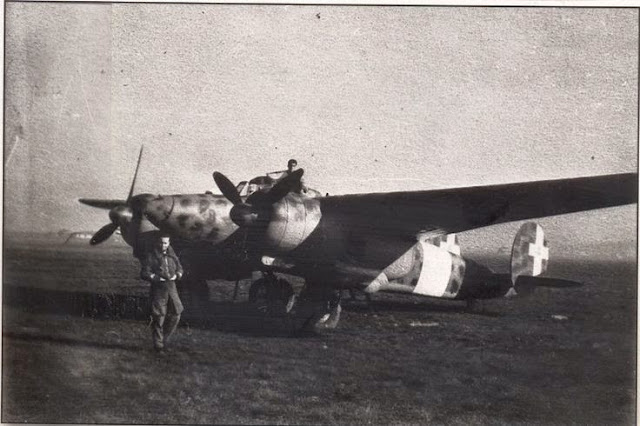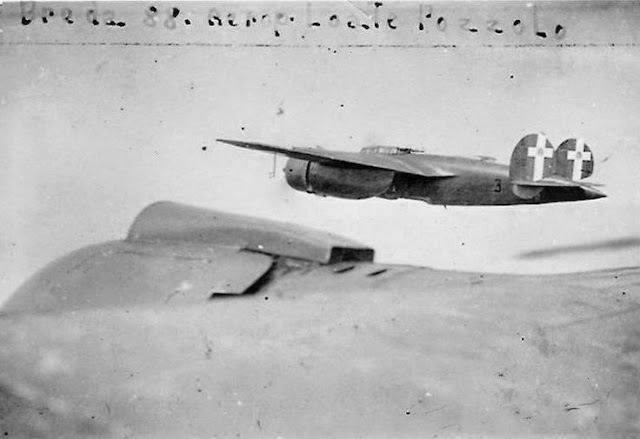 |
| Breda Ba.88 Lince |
The Germans were very interested in having the Italians as their allies throughout World War II. Adolf Hitler courted fellow dictator Benito Mussolini assiduously, and ultimately got him to declare war - a bit tardy, but better late than never - on 10 June 1940, just as France was on the ropes.
While the Italians did not contribute much militarily except here and there - the Blackshirts often fought hard and heroically, but the masses of Italian conscripts did not, and that is a fact - they did offer the Germans a lot of strategic help. This was primarily geographic - while the Italians themselves did not do much, their country served as a springboard into the Mediterranean and North Africa. At various points during the conflict, especially the summer of 1942, the Germans were able to use Italian territory for air bases to almost shut down the Mediterranean to the British. Had Hitler not foolishly attacked the USSR, he could have (as recommended by his Generals) instead easily cut the British lifeline through the Suez Canal to India and the Far East. This he could have done via Italy. Egypt then would have been easy pickings for Rommel. The country also served as a huge distraction for the Allied military in 1943, when they expended huge effort and thousands of lives to invade, only to find that the territory they occupied was next to useless to the German war effort. It was so easy to defend because of its series of lateral mountain ranges that it bled off a huge Allied military effort to the advantage of the German defenders, who used the time wasted by the Allies in Italy to prepare their defenses in northwest Europe.
Winston Churchill, meanwhile, had a different attitude about Italy. One night at a dinner party before the war, he listened respectfully to German Foreign Minister Joachim von Ribbentrop, who was a pompous windbag who never should have stopped selling champagne. Ribbentrop (he bought the "von") droned on and on as was his custom about how the Third Reich was invincible and would have mighty Italy as an ally in any future war against Britain. When Ribbentrop finally finished, Churchill simply responded:
“That’s only fair – we had them last time.”The Breda Ba.88 Lince ("Lynx") helped prove Churchill's attitude to be the correct one.
 |
| The Lynx |
During the Thirties, Italian aviation was considered top-notch. Many of the Italian aircraft performed well at the air races and air cruises that were common at the time. These were conducted with the planes completely empty, mere shells dragged along by the engines, but performance was carefully measured. The Italian aircraft were quite impressive under those conditions, which led to a whole series of misconceptions about its worth as a military ally.
The Lynx was an all-metal, twin-engine, two-crew fighter-bomber. It was the Italian version of the German Bf 110, a heavy fighter that could take a lot of punishment - and dish some out as well.
 |
| Lynxes in rare squadron formation |
The engines were Piaggio P.XI air-cooled radial engines, common Italian power plants of the day. They ultimately proved extremely troublesome, but on paper - like the entire Italian air force - they were impressive. Armament was three nose-mounted 12.7 mm Breda machine guns. Another machine gun was located pointing rearward at the rear of the cockpit, a common set-up, though this one fired without a gunner. It could carry three bombs of 250, 100 and 50 kg, not much by later standards, but adequate at the time for a plane that basically was a fighter. Everything in the cockpit was top-notch and cutting edge. A beautiful plane, somewhat stubby but powerful looking.
 |
| A nice shot showing the rear machine gun, controlled by wire |
The plane was fast, setting speed records in 1937. However, it turned out to be under-powered when fitted with military equipment. Engines are tricky things, sometimes performing well with lighter loads and awful with heavier ones. Some Lynxes flew in the very early stages of the war against the island of Corsica. With no aerial opposition whatsoever, they did all right, dropping their light loads of bombs and returning home to acclaim. Hopes were high that this heavy fighter could make a serious contribution to the Axis hopes of conquest in the Mediterranean and even against England. A strong Italian air effort could have perhaps helped remove the thorn of Malta and even lead to the conquest of North Africa.
On their first mission against a real enemy who could fight back, three Lynx aircraft were sent out from Castelvetrano in western Sicily against some British forces in North Africa. Only two got airborne, and one of the other two pilots found that his aircraft wouldn't turn. He had to fly straight all the way across the sea to an Italian base in North Africa to land. It is quite comical to think about. Further problems developed in subsequent missions against England, and even when they flew, the aircraft could not carry any bombs or other useful equipment due to their high wing loading, i.e., they could barely lift themselves off the ground let alone with anything inside of them. Eventually, all of the Lynxes were left to rot on the airfields, stripped of equipment, providing tempting targets for British and American bombers. They were quite useful in that role, attracting a lot of bombs and gunfire that might have been directed against useful aircraft.
The disaster was not quite over. Mussolini kept the production lines running for political reasons, to keep people employed. Italy had nothing better to build anyway, while the Germans were desperately opening new war production factories everywhere they could. Many more Lynxes were built - 164 in all - even though the pilots knew after the first handful that they were completely useless. Almost all were sent directly to the scrap yard. Italy had some very good light fighters during the war, but never came up with a suitable heavy fighter after the disaster that was the Breda Ba.88. The plane is not mentioned in most histories of the war - even those specifically dealing with the Italian air force - because in Italian aviation circles it is considered a national embarrassment.
But they looked really cool.
2014



No comments:
Post a Comment